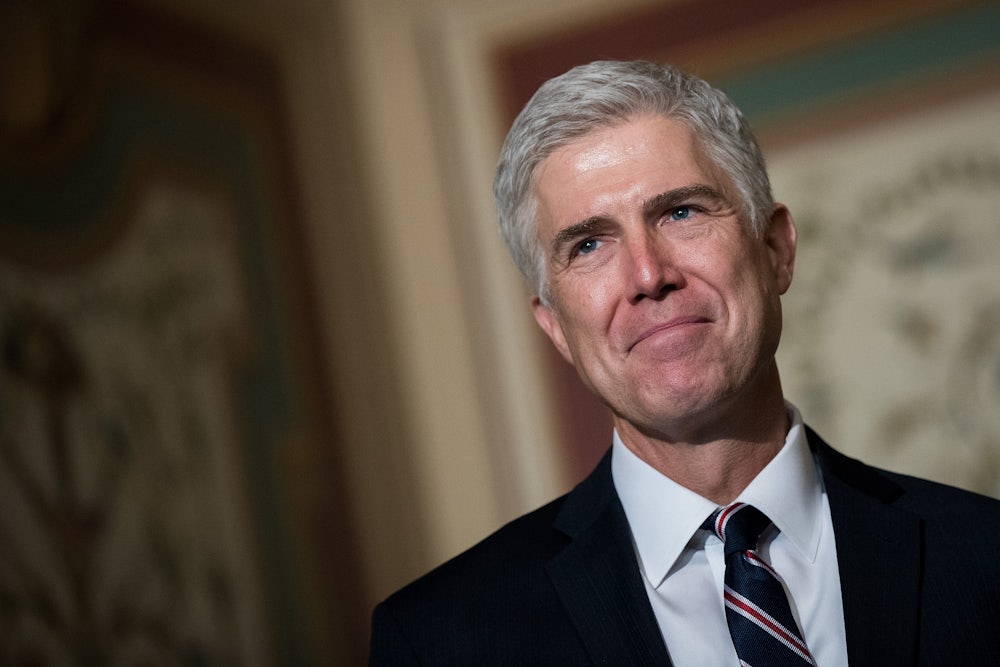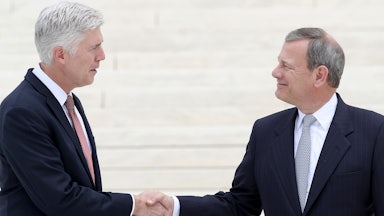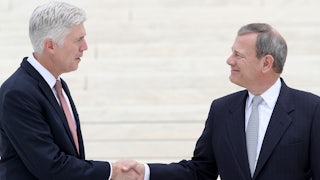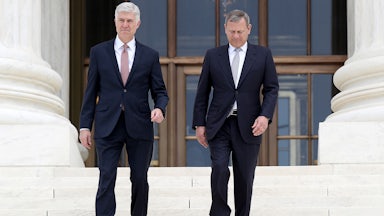If you avidly track the byzantine ways in which Medicare reimburses health care providers for drug costs, then Tuesday’s oral arguments in American Hospital Association v. Becerra are probably your version of a NFL wild-card playoff game. Sure, it’s not the Super Bowl. That might be Congress’s ongoing discussions about vastly expanding Medicare’s drug-price negotiation powers. But Medicare nerds might still relish what will likely be a hyper-technical debate before the Supreme Court over the program’s reimbursement practices.
For millions of other Americans, AHA v. Becerra is more significant in less obvious ways. The Supreme Court won’t just be considering whether the Department of Health and Human Services misread the laws that structure Medicare. The justices will also consider how much deference to give federal agencies when interpreting those laws—a seemingly minor question with vast implications for federal regulatory agencies, for congressional powers, and for American democracy itself.
The case springs from the complex ways in which Medicare reimburses—and, in certain cases, subsidizes—significant parts of the American health care system. One of those parts are the nonprofit hospitals that fall under Medicare’s Section 340B Drug Pricing Program. The program requires drug manufacturers to sell drugs to health care providers in poor and underserved communities at reduced-rate prices. A separate provision in federal law sets the “average price” of a drug’s cost, which determines how much Medicare reimburses a provider, at 106 percent of its average sale price.
The additional 6 percent saves Medicare the logistical trouble of going through each hospital’s payment records to determine reimbursement. But it also warps the system in other ways. Nicholas Bagley, a University of Michigan law professor, noted on SCOTUSblog on Monday that because “6 percent of a large number is bigger than 6 percent of a small number, hospitals have an incentive to dispense more expensive drugs, even when there are cheaper and equally effective therapies.” That perverse incentive helps account for some of Medicare’s ballooning drug-reimbursement costs in general each year.
What’s more, when applied to 340B hospitals, the 106 percent rate has an even greater impact. Since 340B hospitals already pay below-market rates for many drugs, Bagley noted, the result of the two rules’ interaction is a windfall of sorts for the program’s participants. 340B hospitals readily acknowledge this and argue that it’s a net positive for Americans: They explain that the additional reimbursements from Medicare allows them to subsidize other medical costs they incur, thus enabling them to more readily serve low-income or underserved communities.
In 2018, the Department of Health and Human Services sought to end that gap and cut reimbursements to 340B hospitals. According to the department, HHS officials were empowered to make the cuts based on provisions of the federal law structuring Medicare that give the agency broad discretion for making cost-related decisions. The American Hospital Association and its allies argue that HHS “imposed upon them a devastating $1.6 billion annual revenue loss [and imperiled] their vital mission” without following the procedures set forth by Congress in a 2003 law for outpatient-drug costs.
So, whose reading of the law is right? A federal district court initially ruled in favor of the AHA, holding that HHS had gone beyond the bounds that Congress had authorized when cutting drug-reimbursement rates for 340B hospitals. But the federal government appealed that ruling and convinced a three-judge panel on the D.C. Circuit Court of Appeals to overturn it. Two of the panel’s judges—including then-Judge Merrick Garland before embarked on his current stint as attorney general—ruled that HHS had made its decision based upon a “reasonable interpretation” of the relevant federal law.
What gave HHS an edge in the case was a legal doctrine known as Chevron deference. Its name comes from a 1984 Supreme Court case between the eponymous oil giant and environmental groups over how the Environmental Protection Agency defined and interpreted a specific term in the Clean Air Act. The justices held that, generally speaking, courts should defer to how an agency interprets an ambiguous provision of federal law if the agency offers a “permissible construction” of the statute in question and Congress hasn’t contradicted it. Chevron deference, in short, requires the courts to defer to an agency’s interpretation of federal law as long as it’s a reasonable one.
Earlier this year, the AHA and its allies asked the Supreme Court to overturn the D.C. Circuit’s decision and revisit Chevron deference itself. They had good reason to think the justices would take up the case. In conservative and libertarian legal circles, Chevron deference is often criticized for purportedly giving too much discretion to federal regulators at the expense of the federal judiciary and, in a roundabout way, Congress itself. “Most conservative jurists once believed Chevron would buttress the separation of powers,” The Wall Street Journal’s editorial board noted on Monday in an editorial on the case. “But many have had second thoughts as judges abdicate their constitutional duty to interpret statutes, and administrative agencies arrogate to themselves the legislative and judicial authority to write and interpret laws.”
Most members of the Supreme Court’s conservative bloc have aired similar complaints. Perhaps most famously, Justice Neil Gorsuch sharply criticized Chevron deference while serving on the Tenth Circuit Court of Appeals, arguing that it allowed “executive bureaucracies to swallow huge amounts of core judicial and legislative power and concentrate federal power in a way that seems more than a little difficult to square with the Constitution of the framers’ design.” (Ironically, Gorsuch’s mother led the EPA when the agency wrote the rule at issue in the Chevron case.) By favoring an agency’s interpretation, Gorsuch concluded, Chevron deference “seems no less than a judge-made doctrine for the abdication of the judicial duty.”
Many liberals see the right-wing critiques of Chevron deference as part of a broader campaign against the legal underpinnings that allow modern regulatory agencies to function. Many conservative legal scholars and most of the conservative justices, for example, have expressed interest in resurrecting the nondelegation doctrine. The doctrine, which hasn’t been a significant part of American constitutional law for generations, would significantly narrow Congress’s ability to vest rulemaking discretion in agencies like the Food and Drug Administration or the Environmental Protection Agency. Without that discretion, Congress would likely have to take on most of that burden itself—or, perhaps more likely in today’s politics, abandon some regulatory functions altogether.
There is a particular irony in conservatives’ complaints of a rogue and unaccountable “administrative state.” As Vox’s Ian Millhiser explained earlier this year, the Supreme Court’s original ruling in Chevron was based on the understanding that judges have less policy expertise than the agencies themselves, making them ill-suited to second-guess the judgments of experts. (This reasoning feels particularly apt when navigating the dizzying labyrinth of Medicare’s reimbursement rules.) What’s more, the Chevron Court reasoned, those agencies are accountable to the elected branches—a president who is usually chosen by the American people and a Congress that can override any agency’s interpretation at will—while the courts are not.
In other words, what the critics of Chevron deference see as an unaccountable web of unelected bureaucrats might be better understood as a democratically accountable system of federal agencies that ultimately answer to the nation’s elected officials, either by executive order or act of Congress. But the alternative might be a system where well-funded litigants can get an increasingly right-leaning federal courts and a deeply conservative Supreme Court to rewrite ambiguous federal laws in cases where Congress doesn’t foresee every possible outcome or possibility. That would be a massive shift in the separation of powers—maybe back to Congress and the American people themselves, as Gorsuch and the other justices have suggested, but certainly towards the unelected judges who would be freed from the burden of deference to, well, anyone.










